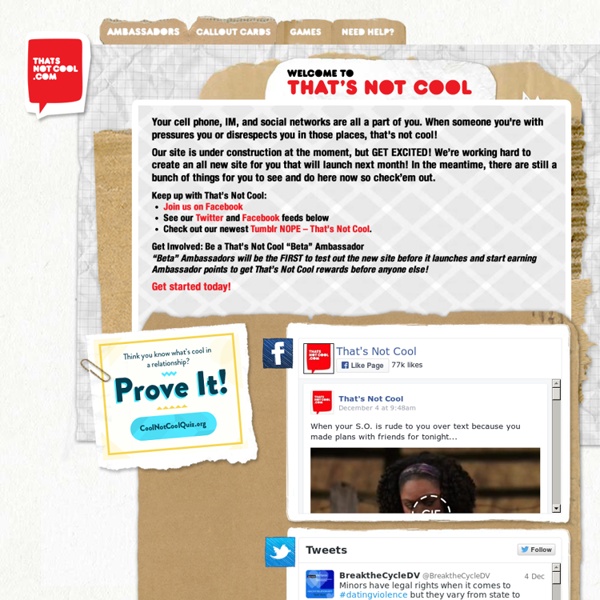



Bullying y cyberbullying: fenómenos en crecimiento Hace un tiempo algunos nos conmovimos cuando nos enteramos de este caso en Australia, que se hizo muy famoso por su circulación en la red: Indudablamente no esfrentamos a un problema que trasciende las fronteras. Para conocer más sobre él, les proponemos leer una nota muy completa que explica aquí el tema y cuenta sus alcances en Chile: Un informe de UNICEF, difundido hace poco en los medios de nuestro país, daba cuenta del crecimiento del fenómeno bullying en las escuelas de Argentina: Algunas organizaciones vienen abordando con preocupación el tratamiento de este tema a través de acciones específicas, como por ejemplo la creación de este grupo: Equipo Bullying Cero Esta nota da cuenta del fenómeno:
Media and Technology Resources for Educators February 27, 2014 We are thrilled to announce the release of our entire Digital Literacy and Citizenship Curriculum as a set of eight interactive, multimedia iBooks Textbooks, available for free in the iBooks Store... read more March 31, 2014 Imagine … a school district that is teaching Digital Literacy and Citizenship lessons to 28,000 K-12 students, with 1,800 trained teachers. Is it possible? Last week, I hosted an inspiring webinar... read more Categories:
Facebook for Parents Facebook is How Our Teens Connect Facebook is a huge part of many teens' lives. They use it to keep up with their friends' activities, play games, chat, post photos -- even do homework. And while public sharing always carries some safety and privacy risks (more on that below), with good judgment and strict privacy settings, Facebook can be used safely. What is Facebook? Facebook is an enormous, free social networking site with hundreds of millions of users all over the world. To use Facebook, you sign up with your email address, name, gender, date of birth, and password. As you complete your profile, you can select the people who can view each piece of information. Why it Matters Teens' willingness to share information can surprise -- and even shock -- parents who aren't used to such public disclosure. But Facebook's privacy settings have evolved since the site first started, and its users have evolved, too. How to Help Your Teen Use Facebook Safely Tips for talking to teens about Facebook
Harcèlement en ligne, pressions psychologiques Les cas les plus fréquents de sexting parmi les adolescents sont les cas où un jeune échange des images ou vidéos dévoilant son intimité avec son petit copain, sa petite copine comme preuve de son amour, ou suite à une demande qu'il ne sait refuser (si tu m'aimes, montre-moi...). Parmi les autres pratiques communes, on citera le phénomène des dedipix (voir article), l'envoie de textos assez crus, et la mise en ligne d'images explicitement sexuelles sur les réseaux sociaux. L'exposition de son corps à l'adolescente ne date pas d'hier et n'est pas forcément un problème en soi. Le sexting est souvent lié à une confusion des genres entre la nudité et la sexualité, dans les cas où la nudité est considérée négativement, à travers des tabous. Eukidsonline 2011 : 14% des 9_16 ont vu durant les 12 derniers mois des images à caractères sesxuelles. 3) e-Réputation > au moment où l'adoslescent construit son identité (en ligne et ailleurs), fort risque de sur-sexualisation + réputation sulfureuse.
Safe Connects | Net Literacy While 99% of all that happens on the net is positive and safe which is very similar to the real world, educating teens about Internet safety helps keep them safe and enables them to enjoy the riches available to them online. Safe Connects is differentiated from other Internet safety programs because students use “straight talk” to discuss topics that are important to teens. This program has established a “student-teaching-students-and-parents” model for school systems throughout America. Safe Connects Cyber Bullying PSA The Safe Connects online safety program is based on three premises: 1. 2. 3. Learn more about Safe Connects by clicking on the “What Is Safe Connects?”
101 VIDEO & AUDIO Home Donna Rice Hughes, president and CEO of Enough Is Enough, will be featured on the Executive Report, American Airlines’ exclusive talk radio programming. The Executive Report features interviews with CEO’s from around the globe. Award-winning producer Mark Larson interviewed EIE President Donna Rice Hughes for a 30 minute Internet Safety 101 Radio program. Enough Is Enough℠ interviewed top clinicians, psychologists, law enforcement officers, industry representatives as well as parents, teens, victims of Internet-initiated sex crimes, a registered sex offender and others about the most compelling and relevant Internet safety topics today. About Enough Is Enough℠ Introduction: The Perfect Storm Despite the Internet's many wonderful benefits, a perfect storm has emerged for the online victimization of children. Pornography 101 Videos What is Pornography? Pornography: Access Kids have free and easy access to online Pornography via the web. Pornography: Harms Empowering Parents Alicia's Story
Violence - cybersmart.ch © sir hiss/photocase Le cyber-harcèlement (appelé aussi cyberbullying ou harcèlement sur le net) veut dire insulter, menacer, embarrasser, harceler d’autre utilisateurs. Ce qui signifie donc «bizuter», maltraiter à l’aide des médias. Ce qui est particulier dans le cyber-harcèlement c’est que ces chicanes se produisent à n’importe quelle heure, que les auteurs sont généralement anonymes, et que les photos, les vidéos et les textes se propagent très rapidement. La forme la plus connue est la propagation d’images humiliantes ou de films d’agressions téléchargés sur internet ( happy slapping Le plus souvent, l’agresseur/euse fait partie de l’environnement immédiat de la victime. Parmi les adolescent-e-s, la possession, la consommation et le partage d’images et de vidéos à contenus violents et/ou pornographiques sont de plus en plus répandus.
Katie Christo's Wiki / Digital Citizenship and Safety Digital Citizenship New Northern Gateway Digital Citizenship Resources - 10 Digital Citizenship Tips from your Mother - Commonsense Media Digital Literacy and Citizenship Classroom Curriculum 9 Elements - now will look like: Digital Safety 11 Resources for Teaching and Learning Web Safety - Admongo.gov - Advertising is all around you. Avatar Creators